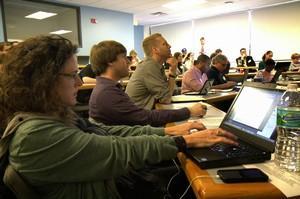IRE Radio
IRE Radio Podcast | The Problem with Witness Protection
When the Washington, DC police chief bristled over a question about witness executions, Washington Post reporter Cheryl W. Thompson knew she was on to something. On this episode we’ll be talking to Thompson about her investigation into witness killings and intimidation. And for the second half of the show we dug into our audio archives…
Read MoreIRE Radio Podcast | The Reporter Who Brought Down the Governor
Meet Nigel Jaquiss, the Pulitzer-winning journalist whose reporting brought about the resignation of Oregon’s longest-serving governor. Today we’re exploring Jaquiss’ path from Wall Street oil trader to muckraking journalist. He’s sharing his process for working through an investigation and explaining how he broke stories about some of the state’s most powerful politicians. We’ll also take…
Read MoreIRE Radio Podcast | The Navy’s Most Crash-Prone Helicopter
When a Navy helicopter crashed off the coast of Virginia in January 2014, Jason Paladino lost one of his childhood friends – Petty Officer Third Class Brian Collins. But instead of grieving the loss and moving on, Paladino, a journalism grad student at UC-Berkeley, decided to investigate. Working with The Virginian-Pilot and NBC News he…
Read MoreIRE Radio Podcast | Product of Mexico
We’re changing up the podcast this week and spending our entire episode on one story. IRE’s Shawn Shinneman talked with Los Angeles Times reporter Richard Marosi about his 18-month investigation into the working conditions of Mexican agribusinesses supplying produce to major U.S. supermarkets and restaurants. Tune in to hear Marosi discuss the reporting challenges he…
Read MoreIRE Radio Podcast | Killed by the Cops
How many times a year do police kill people? And what happens to officers after they fire a fatal shot? Those were just some of the questions prompted by the deaths of Michael Brown in Ferguson, Missouri and Eric Garner in New York. On this episode of the IRE Radio Podcast we’ll be talking to…
Read MoreAudio from 2014 Watchdog Workshops now available for download
Participants at the Jacksonville Watchdog Workshop. (Photo courtesy of Tracey Eaton) Couldn’t make it to one of our Watchdog Workshops this year? We recorded audio from many of our panels and, thanks to a generous grant from the Ethics and Excellence in Journalism Foundation, have made it available for download online. We have recordings from…
Read MoreIRE Radio Podcast | Navigating Nonprofits
Americans donate about $300 billion a year to charities, with about 30 percent of that taking place in December. But not all charities are good stewards of donated dollars. For our last podcast of 2014 we’re talking about how to investigate nonprofits and charities. Here’s the lineup: Justin Elliott of ProPublica talks about investigating the…
Read MoreAUDIO: How to find specific forgotten victims
At the 2014 IRE Conference, a panel of three journalists, moderated by New England Center for Investigative Reporting senior investigative reporter Jenifer McKim, talked about finding how they found forgotten victims and tackled overlooked issues. Senior citizens in nursing homes and assisted living facilities, Detroit citizens unfairly affected by the city’s recent bankruptcy, black lung-afflicted…
Read MoreIRE Radio Podcast | Housing Horror Stories
It’s a special Halloween episode of the IRE Radio Podcast, and this week we’re telling some housing horror stories. Here’s the lineup: Marisa Kwiatkowski of The Indianapolis Star talks about her story “The exorcisms of Latoya Ammons,” which became the most-read story in the Star’s history. Kate Berry of American Banker explains “zombie foreclosures” and…
Read MoreAUDIO: How to track and report on gun violence
There is no perfect or universal way to classify a mass shooting. As such, reliable, nuanced data on the topic is sparse. And further complicating the reporter’s job is the way even the most human stories can become fuel for the right-versus-left fire. It’s with these challenges in mind that three reporters and researchers came…
Read More
